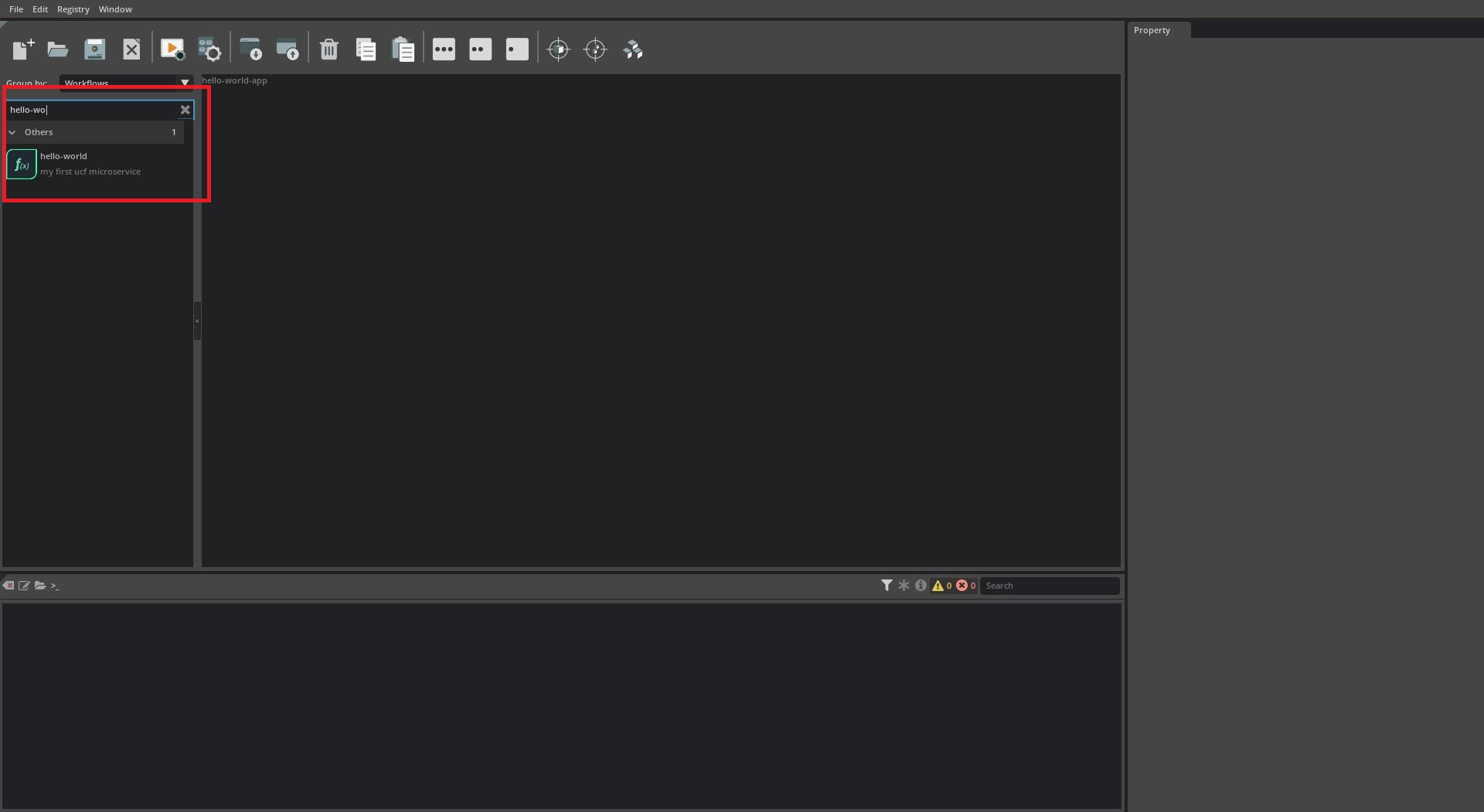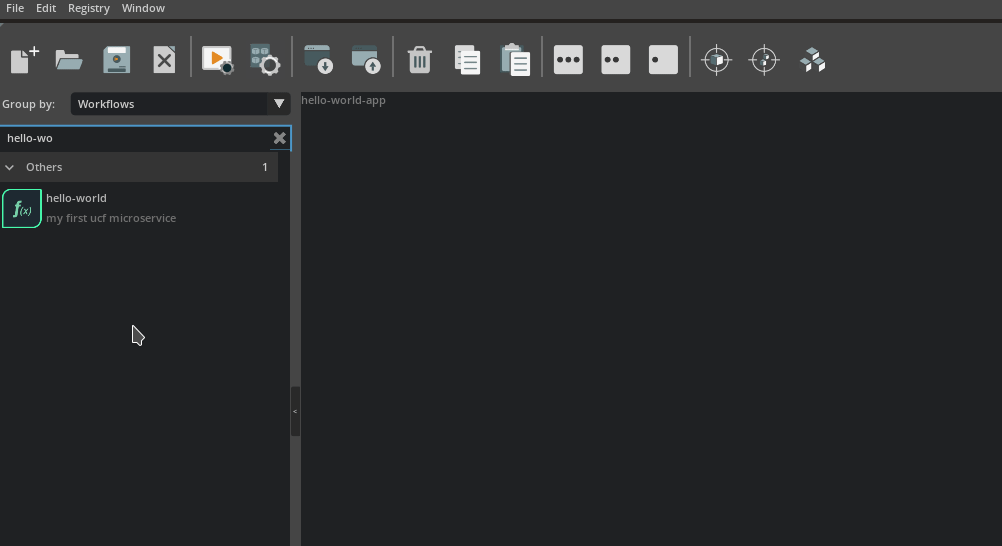Hello World#
Housekeeping#
See the Getting Started documentation for installing and setting up:
microk8s
UCS Tools
accessing NGC
setting up repositories
Introduction#
In this tutorial, we will create a simple, one-service “hello world” application that will sleep for 10,000 seconds.
This will help you get familiar with the basics of:
defining microservices,
building microservices using
ucf_ms_builder_cli,defining applications from microservices,
building applications using
ucf_app_builder_cli,deploying and running microservices and applications,
inspecting and debugging running services,
stopping and cleaning up microservices and applications.
Before we do that, let’s create an empty project:
cd $HOME
mkdir -p ucf_tutorial/{services,apps}
Creating a Microservice#
Now, let’s create our first microservice: .. code-block:
cd $HOME/ucf_tutorial/services
ucf_ms_builder_cli service create -n hello-world -i container-image
This should generate and populate hello-world directory in ucf_tutorial/services
Replace the default hello-world/manifest.yaml with the following:
type: msapplication
specVersion: 2.5.0
name: ucf.svc.hello-world
chartName: hello-world
description: my first ucf microservice
version: 0.0.1
tags: []
keywords: []
publish: false
---
spec:
- name: hello-world-service-a
type: ucf.k8s.app.deployment
parameters:
apptype: stateless
- name: hello-world-service-a-container
type: ucf.k8s.container
parameters:
image:
repository: nvcr.io/nvidia/pytorch
tag: 22.04-py3
command: [sh, -c]
args: ["echo 'hello, world!' && sleep 10000"]
The first several lines define the microservice itself - the type of the microservice, the version of the specification, the name of the chart, description, the version of the microservices, tags and keywords, and whether to publish to UCS registry on CI pass. These are pretty straightforward and boilerplate for every microservice.
The real details of our microservice are defined after the spec keyword - each piece listed thereafter is a UCS Component following a structure of:
Name
Type
Parameters
In this simple microservice, we define two components:
A component named
hello-world-service-aand of typeucf.k8s.app.deploymentwith a parameter ofapptypeset tostateless, andA component named
hello-world-service-a-containerand of typeucf.k8s.containerwith several parameters.
In future tutorials, we’ll explore adding other components like:
ucf.k8s.servicefor Ingress/Egress connections,ucf.k8s.volumefor adding storage,ucf.k8s.initcontainerfor performing setting up steps before running another container,ucf.k8s.podSecurityContextfor using root permissions in non-root containers,ucf.k8s.restartPolicyfor defining how containers should behave after a restart, and many more.
For now, it’s enough for our “hello world” example to understand that we are defining a Deployment - a K8s construct for controlling the way that pods behave - as well as a Container that will be used to populate our pods.
For more information on UCS Components such as their purpose and properties, you can run the below:
$ ucf_ms_builder_cli component info -c ucf.k8s.app.deployment
type: ucf.k8s.app.deployment
description: Deployment workload
properties:
apptype: (string ), Pod deployment type (stateful/stateless). [Mandatory:True, Allowed Values:{ stateful, stateless, job, cronjob, daemonset, replicaset }]
$ ucf_ms_builder_cli component info -c ucf.k8s.container
type: ucf.k8s.container
description: Container as per AppSpec
properties:
image: (object ), Container image. [Mandatory:True]
repository: (string ), Container image repository address. [Mandatory:True]
tag: (['string', 'number']), Container image tag. [Mandatory:True]
pullPolicy: (string ), Container image pull policy [Mandatory:False, Allowed Values:{ Always, Never, IfNotPresent }]
workload: (string ), Name reference to a workload defined. [Mandatory:False]
command: (array ), Array of command line strings to be executed. [Mandatory:False]
args: (array ), List of arguments to the entrypoint. [Mandatory:False]
env: (array ), Array of environment variables to be set. [Mandatory:False]
livenessProbe: (object ), Liveness probe for the container [Mandatory:False]
readinessProbe: (object ), Readiness probe for the container [Mandatory:False]
startupProbe: (object ), Startup probe for the container [Mandatory:False]
ports: (array ), List of container ports to be exposed [Mandatory:False]
resources: (object ), Container resource requirements [Mandatory:False]
limits: (object ), Maximum amount of compute resources allowed [Mandatory:False]
requests: (object ), Minimum amount of compute resources requires [Mandatory:False]
volumeMounts: (array ), Container volume mounts. [Mandatory:False]
name: (string ), Volume mount name. [Mandatory:True]
mountPath: (string ), Volume mount path. [Mandatory:True]
Building Microservices with ucf_ms_builder_cli#
Now that we’ve defined our microservice, let’s build it using ucf_ms_builder_cli:
$ ucf_ms_builder_cli service build -d hello-world/
2022-12-05 15:02:50,264 - Registry - INFO - Building: hello-world/
2022-12-05 15:02:51,641 - MsBuilder - INFO - Helm chart generated in hello-world/output/helm
2022-12-05 15:02:51,651 - MsBuilder - INFO - MS spec generated in hello-world/output/msspec
2022-12-05 15:02:51,887 - MsBuilder - WARNING - Mandatory compliance checks failed. Check hello-world/output/compliance_test_logs.txt for more information
2022-12-05 15:02:51,995 - MsBuilder - INFO - MS spec generated in hello-world/output/msspec
2022-12-05 15:02:51,998 - MsBuilder - INFO - Tests generated in hello-world/output/tests
2022-12-05 15:02:52,005 - Registry - INFO - Generating service helm chart package...
2022-12-05 15:02:52,254 - MsBuilder - INFO - Added microservice 'ucf.svc.hello-world:0.0.1' to local repository
This creates the helm chart for the microservice which can be used to create applications.
Since our service is a standalone service, we can simply deploy our microservice as there are no dependencies. To deploy on our local microk8s cluster, run::
microk8s helm install myfirstservice hello-world/output/helm/
Output:
NAME: myfirstservice
LAST DEPLOYED: Tue Nov 29 10:29:01 2022
NAMESPACE: default
STATUS: deployed
REVISION: 1
TEST SUITE: None
Once the pod is in the Running state, which can be found out using microk8s kubectl get pods, you can run microk8s kubectl logs <POD_NAME> which should print::
hello, world!
You just created and deployed your first UCS Microservice! Generally, microservices will be deployed as part of an application. We will look at how to create one in the next section.
Creating Applications using Microservices - CLI Tools and Textual Format#
In this section, we create a simple application with the microservice we just created.
Run:
$ cd $HOME/ucf_tutorial/apps
$ ucf_app_builder_cli app create hello-world-app
This will create a directory hello-world-app with app.yaml and a README.md file.
Replace the contents of the default app.yaml with the following:
specVersion: 2.5.0
version: 0.0.1
doc: README.md
name: hello-world-app
description: Hello World Application
dependencies:
- ucf.svc.hello-world:0.0.1
components:
- name: helloworld
type: ucf.svc.hello-world
Now let’s try to understand our application. The top several lines again specify the metadata of the application - similar to how our hello-world microservice was defined.
Under dependencies, we can specify the various microservices and their versions that we will use to compose our application.
Under components, we can specify UCS Components and their parameters i.e. different microservices to create the application. For this application, we only have 1 microservice.
Under connections (not shown here) - we can specify Egress/Ingress connections between microservices to enable them to talk to each other. We’ll demonstrate that in the next chapter.
Building Applications with ucf_app_builder_cli#
Now that we’ve defined our application, let’s build it using ucf_app_builder_cli::
$ ucf_app_builder_cli app build hello-world-app/
2022-12-05 15:37:45,567 - AppBuilder - INFO - Syncing any missing service versions to cache...
2022-12-05 15:37:45,568 - AppBuilder - INFO - Validating application ...
2022-12-05 15:37:45,570 - AppBuilder - INFO - Building application hello-world-app-0.0.1 ...
2022-12-05 15:37:45,845 - AppBuilder - INFO - Application compliance report generated at hello-world-app/hello-world-app-0.0.1/compliance_report.json
2022-12-05 15:37:45,845 - AppBuilder - INFO - Application Helm Chart generated in hello-world-app/hello-world-app-0.0.1
2022-12-05 15:37:45,845 - AppBuilder - INFO - App built
Great! The application is built.
Creating and Building Application using Studio#
Building the microservice also adds it to the local repository and can be used for building applications using UCS Studio.
Launch UCS Studio and create a new graph
Follow steps in Launch UCS Studio and Create New Graph
Search for newly built microservice
Search for the newly built microservice by typing it’s name in the search box for microservices in left pane

Add the microservice to the App
Add the microservice to the application by selecting it in the microservice list on the left and drag-dropping it on to the canvas.
Save and Build the App
Follow steps in Save and Build the Application to generate the application helm chart
Deploying and Running Microservices and Applications#
Let’s next prepare to run the application by seeing if there are any services currently running::
$ microk8s kubectl get all
NAME TYPE CLUSTER-IP EXTERNAL-IP PORT(S) AGE
service/kubernetes ClusterIP 10.152.183.1 <none> 443/TCP 12d
To run the application execute:
$ microk8s helm3 install helloworld ./hello-world-app/hello-world-app-0.0.1/
WARNING: Kubernetes configuration file is group-readable. This is insecure. Location: /var/snap/microk8s/3597/credentials/client.config
NAME: helloworld
LAST DEPLOYED: Mon Aug 8 15:02:53 2022
NAMESPACE: default
STATUS: deployed
REVISION: 1
TEST SUITE: None
Inspecting and Debugging Microservices and Applications#
Once the application is successfully deployed, we can check the deployment:
$ microk8s kubectl get all
NAME READY STATUS RESTARTS AGE
pod/hello-world-hello-world-service-a-7b786695ff-4wwz7 1/1 Running 0 65m
NAME TYPE CLUSTER-IP EXTERNAL-IP PORT(S) AGE
service/kubernetes ClusterIP 10.152.183.1 <none> 443/TCP 81d
NAME READY UP-TO-DATE AVAILABLE AGE
deployment.apps/hello-world-hello-world-service-a 1/1 1 1 73m
NAME DESIRED CURRENT READY AGE
replicaset.apps/hello-world-hello-world-service-a-7b786695ff 1 1 1 65m
We can also describe the pods and look at the events section to understand the current Status:
$ microk8s kubectl describe pod hello-world-hello-world-service-a-7b786695ff-4wwz7
<omitting>
...
...
...
<omitting>
Events:
Type Reason Age From Message
---- ------ ---- ---- -------
Normal Scheduled 98s default-scheduler Successfully assigned default/hello-world-hello-world-service-a-7b786695ff-4wwz7 to rtxstation
Normal Pulling 98s kubelet Pulling image "nvcr.io/nvidia/pytorch:22.04-py3"
Normal Pulled 90s kubelet Successfully pulled image "nvcr.io/nvidia/pytorch:22.04-py3" in 8.651257285s
Normal Created 90s kubelet Created container hello-world-service-a-container
Normal Started 89s kubelet Started container hello-world-service-a-container
Warning DNSConfigForming 17s (x5 over 99s) kubelet Search Line limits were exceeded, some search paths have been omitted, the applied search line is: default.svc.cluster.local svc.cluster.local cluster.local hsd1.il.comcast.net vdiclient.nvidia.com nvprod.nvidia.com
We can see the trailing logs of a particular container in a pod by running:
$ microk8s kubectl logs -f hello-world-hello-world-service-a-7b786695ff-4wwz7
hello, world!
^C
And we can enter a container in a pod by running:
$ microk8s kubectl exec -it hello-world-hello-world-service-a-7b786695ff-4wwz7 -- bash
root@hello-world-hello-world-service-a-7b786695ff-4wwz7:/workspace# ps aux
USER PID %CPU %MEM VSZ RSS TTY STAT START TIME COMMAND
root 1 0.0 0.0 4280 580 ? Ss 20:03 0:00 sleep 10000
root 18 0.7 0.0 9828 7720 pts/0 Ss 20:05 0:00 bash
root 322 0.0 0.0 7652 3204 pts/0 R+ 20:05 0:00 ps aux
Stopping and Cleaning up Microservices and Applications#
Finally, to stop and clean up the application we can run:
$ microk8s helm3 uninstall helloworld
WARNING: Kubernetes configuration file is group-readable. This is insecure. Location: /var/snap/microk8s/3597/credentials/client.config
release "helloworld" uninstalled
